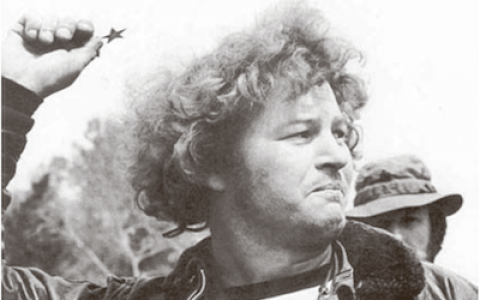Hardhats, Hippies, and Hawks: The Vietnam Antiwar Movement as Myth and Memory
By Penny Lewis
A lot of books get published. Some are worth reading. Occasionally one comes along that is so complete, so thoughtful and so well-argued that not only does it move the discussion, it closes it. In Hardhats, Hippies, and Hawks: The Vietnam Antiwar Movement as Myth and Memory, City University of New York sociologist and labor educator Penny Lewis does that to a reigning myth - that the mass movement against the United States' war in Southeast Asia comprised mainly spoiled college kids, and that the true, authentic blue-collar Americans backed the war with brio. That's a slick line to propagate. Not only does an image like that of construction workers attacking protesters (as famously occurred on Wall Street in May 1970) justify foreign interventions and military spending, it stigmatizes dissenters as illegitimate and alien to the body politic. That grossly distorts real working class sentiment or the class composition of protesters, all to divide critics themselves.
Slick as it was, the line was not true, says Lewis, whose work in this remarkably readable and textured analysis shows us the past isn't so much remembered as "reconstructed," in schools, by the media and elsewhere. Even contemporary polls by Gallup showed that the greater one's education, the more likely one was to support the Vietnam War. That is the reverse of the urban myth that blue-collar families were the war's key defenders and that a privileged and ungrateful elite - what neoconservatives would soon name a "new class" - was responsible for defeat in the field. It's an old trope, that wars are lost not through military blunders, or because they were undertaken for the worst possible reasons, or because the domestic effects from an indefensible and bankrupting military adventure estrange growing numbers of people, but because of a "stab in the back" by a willful and disloyal minority.
In fact, as Lewis demonstrates, the U.S. drive to stabilize what quickly became a series of military dictatorships in South Vietnam was defeated through the resistance of the Vietnamese and the disintegration of a near-mutinous U.S. army in the field. As for the antiwar movement at home, Lewis calculates that some tens of millions of Americans took part at its height, with the majority of Americans opposing the war. If the movement began on elite campuses and with the help of traditional pacifist and left organizations, Lewis demonstrates how it quickly grew to encompass communities of color, including civil rights organizations aghast at the domestic cost of the war, parents with a real expectation of losing sons in a pointless slaughter, mid-level trade union officials and rank-and-file union members bucking their war-abetting union leaders, and returning troops - typically with no more than a high-school diploma or GED - very publicly discarding their medals in antiwar mobilizations while helping build the GI coffeehouse efforts. And with the draft swelling resisters' ranks, the now grounded multi-class movement changed a bipartisan consensus among Washington policy-makers that "rolling back communism" and "defending freedom" were both fair statements of war aims, let alone real possibilities. Communism would within a generation be rolled back, but by the tenacity of a then ascending global capital, not by the U.S. military.
Meanwhile, the antiwar movement http://www.ushistory.org/us/55d.asp never transcended its own limitations. Once the body bags stopped flowing home and the draft ended in 1973, the movement - built on the broadest possible agreement on just one issue (Bring the Troops Home Now!) and never really incorporating the latent critique of imperialism, let alone opposition to capitalism - could not grow into an a radical force capable of challenging the U.S. class system itself. It did spark radicalism among erstwhile liberals (like me) and a real effort to organize working people as anti-capitalists at home, where those of us who began purely as war critics and activists grew into radicals of one stripe or another in unions, community organizations and academia. If anything, the meme propagated by some leftists that workers were big backers of imperialism backfired with many of the most dedicated campus antiwar activists, setting the stage for much of the working class organizing that former student radicals did during the 1970s. In myriad industrial cities we found - surprise! - young workers not that different from us, just having different life chances.
Lewis does much more than just debunk a pernicious myth with her multifaceted and complete analysis. Her effort to complete an exhaustively detailed analysis of a huge movement - one that never received the sort of scholarly attention given to other key upsurges of the 1960s, including the Civil Rights movement - is commendably aimed at confounding what she calls "a faulty memory frame" while forging a true "countermemory." Thanks to scholars like Lewis, history isn't always written by the winners.
[Michael Hirsch, the first in his family to attend college, was a campus antiwar leader, a college professor in Boston as long as he could stand it, then a steelworker in Indiana until the mass layoffs of the early 1980s. Since 1985, he has worked as a labor editor and writer for three New York-based labor unions, as well as a contributor to numerous publications.]
[Thanks to the author for sending this to Portside.]


Spread the word